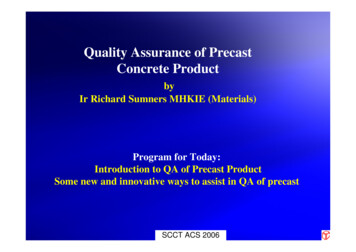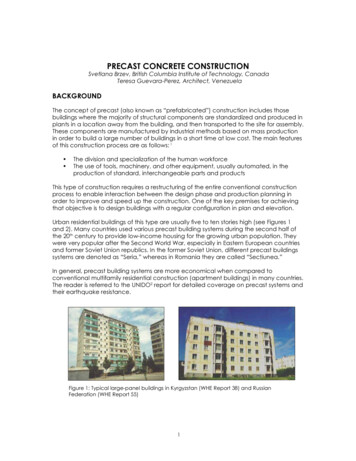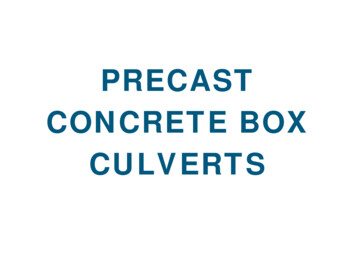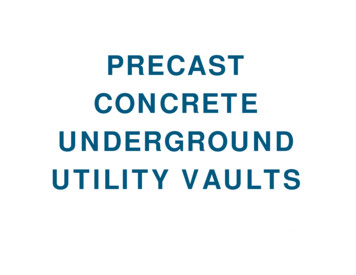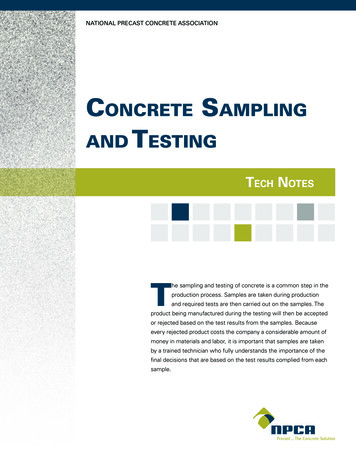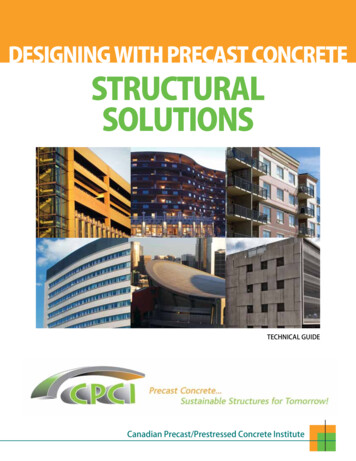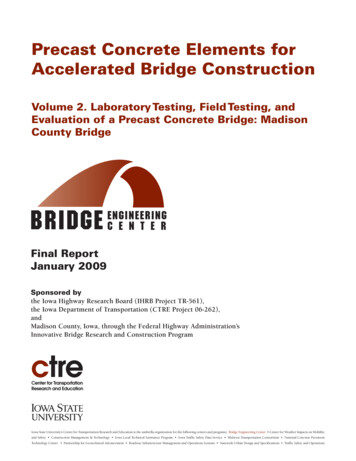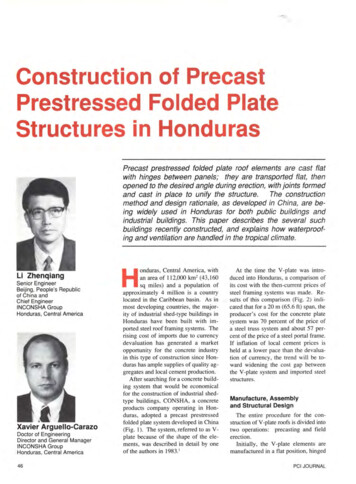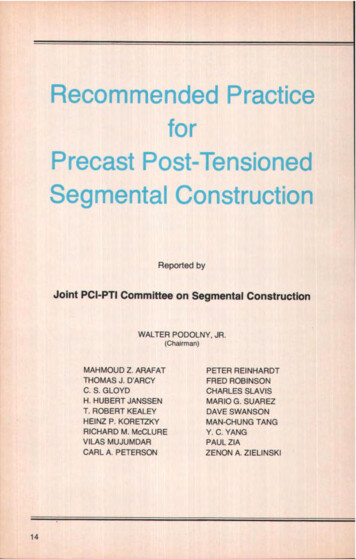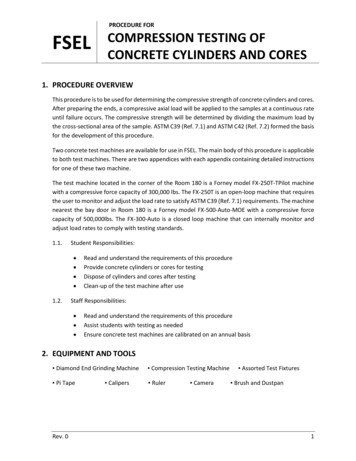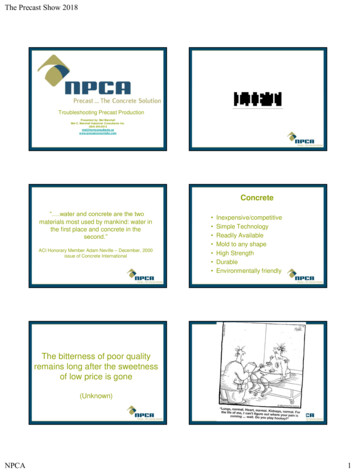
Transcription
The Precast Show 2018Troubleshooting Precast ProductionPresented by: Mel MarshallMel C. Marshall Industrial Consultants Inc.(604) .comConcrete“ .water and concrete are the twomaterials most used by mankind: water inthe first place and concrete in thesecond.”ACI Honorary Member Adam Neville – December, 2000issue of Concrete International Inexpensive/competitiveSimple TechnologyReadily AvailableMold to any shapeHigh StrengthDurableEnvironmentally friendlyThe bitterness of poor qualityremains long after the sweetnessof low price is gone(Unknown)NPCA1
The Precast Show 2018What’s Important? Aggregates – FM, absorption, gradation, clean, etc.Powder – cements, SCMsWater – moisture control, how to determine absorption, etc.Mix Designs – how SG affects volumes, causes of over/under yielding, etc.Air Content – good and bad airSCC - potential problems, required tests, etc.Reinforcing – importance of spacing, location, etc. and typesConsolidation – how to size and locate vibrators, using stingers correctlyCuring – why it is important to control temperature, eg. DEF, etc.Certificates – the importance of having and understanding mill certsNPCA Certification – what is required, and why Anything else you want to discussExcellent Reference Books Properties of Concrete by Dr. A. M. (Adam) Neville Self-Compacting Concrete by De Shutter, Bartos,Domone, Gibbs Design and Control of Concrete Mixes - PCAAggregate SpecificationsAggregatesLarger Aggregate Test Check for silt or clay Mason jar test is notofficial test, but only anindication of how muchfine material is present. Check ASTM C33 andFDOT Sections 901 and902 for amount and typeof allowable finematerial. Use a “Mason jar”NPCA ASTM C33 - Normal Weight Aggregates – befamiliar with the required tests ASTM C330 - Lightweight Aggregates ASTM C637 - Radiation Shielding Aggregates(Heavyweight – Hematite, steel shot, steelshavings)Aggregate Size Maximum Size:– The smallest sieve opening through which theentire amount of aggregate is required topass. Nominal Maximum Size:– The smallest sieve opening through which theentire amount of aggregate is permitted topass. Example: ASTM C33 requires that 100% of a # 67coarse aggregate MUST pass the 1” sieve but 90 - 100%MAY pass the 3/4” sieve, therefore # 67 aggregate isconsidered to have a Maximum size of 1” and an NominalMaximum size of 3/4”.2
The Precast Show 2018Gradation Distribution of particle sizes Grading is determined by ASTM C 136 Well graded concrete aggregates will result in fewer voidsbetween particles less cement paste demandAggregate Gradation (Sand) Also known as “sieveanalysis” It is the distribution ofparticle sizes “Well-graded” aggregates:– particles evenly distributedbetween fine and coarse– require less cement andwater than “poorly graded”aggregates– Careful choice of aggregatesprovides for optimization ofcement, water andadmixturesMost Common Sieve SeriesAggregate Gradation Effects bilitySieve Size Size of the screen opening OR The number of openings per lineal inch.For example, #100 sieve has 100 x 100openings in each square inch (i.e. 100 ineach direction)Effect of Gradation(Approximate mix proportions)Sieve 0#200Metric SizeInternational38 mm25 mm20 mm12.5 mm10 mm4.75 mm2.50 mm1.12 mm0.6 mm0.3 mm0.15 mm0.075 mm37.5 mm--19 mm--9.5 mm4.75 mm2.36 mm1.18 mm0.6 mm0.3 mm0.15 mm0.075 mm 33% of 3/8”, #4 – provide strength 33% of #8, #16 – fill the voids 33% of #16, #30, #50 – for finishNot used in FM CalculationNPCA3
The Precast Show 2018Graded AggregateGradation for Leaking ManholesSandSieve Size½”StoneWell Graded BlendWeight 8#100173#2002Total3155½”, 3/8”, #4 is 48.4%#8 and #16 is 16.2%#30 through #200 is 35.4%Aggregate Size Effects:* As the maximum size aggregateincreases, the amount of paste neededfor a given slump decreases.* The maximum aggregate size used in aconcrete mix is dictated by the size of thestructural member and the spacingbetween reinforcing steel.Fineness Modulus (FM) A single number system used to express the finenessor coarseness of an aggregate Higher values indicate coarser grading Sum of cumulative % retained on the standard sieves Certain sieves are NOT counted (even if used) Standard Sieves: 38 mm (1-1/2”), 20 mm (3/4”), 10mm (3/8”), 4.75 mm (#4), 2.50 mm (#8), 1.12 mm(#16), 0.6 mm (#30), 0.3 mm (#50), 0.15 mm (#100). C33 specifies that FM of sand be between 2.3 and3.1 Can be helpful in calculating blends of two materials FM of coarse aggregate can also be calculated andcan aid in blending coarse and medium size materialsFM & Gradation are NOT the SAMEFineness Modulus of Sand The fineness modulus is calculated from theparticle size distribution of the fine aggregate Values for sand suitable for concrete shouldrange between 2.3 and 3.1 Values can’t differ by more than 0.2 Coarse sand has a higher FM than fine sand The FM influences the bulk volume of coarseaggregateNPCA4
The Precast Show 2018Gradation & Fineness Modulus:Gradation & Fineness Modulus:Dry Sample Wt.1267Dry Sample Wt.Sample:gSample:Can you use this SAND tomanufacture Pipe under C76?gRetainedRetainedSieve Size, (mm)Sieve Size, (US)Mass, (g)Ind. % RetainedCum % Retained1501 52.02.02.36#816312.914.91.18#1622818.032.90.6# 3027822.054.91” & 1/2” sieveNOTused tocalculate FM% PassingareSieve Size,(mm)Sieve Size,(US)Mass, (g)Ind. %RetainedCum %Retained% PassingMinMax1501 032.967.150850.6# 3027822.054.945.12560# 5035528.183.017.053097.03.0010FM 2.3FM 3.1Never includethe Panwhen calculatingthe FM0.3# 5035528.183.00.30.15# 10017714.097.00.15# 10017714.0PanPan383.01264100PanPanTotalSieve Loss Check383.01264100 Cum%retained/1002.85 FM90.080.070.060.0FM 2.8550.040.030.020.010.00.0#4#8# 16Sieve Size2.85 FMASTM C33 6.1 FineAggregate0.24%Why Are Aggregates Criticalto the Water Content ofConcrete?ASTM C 33 - 90 6.1Fine Aggregate3/8TotalSieve Loss Check0.24%100.0Percent Passing1267# 30# 50# 100 Aggregates take up the largest amount ofvolume in concrete. Aggregate particle size, distribution,shape, and texture affect the amount ofwater needed in concrete. Therefore, more than any other material,aggregates have the greatest affect onthe water needed for a given concreteworkability (machine-ability)Why Aggregates Effect WaterDemand 1 Unit2 UnitsVolume 2X2X2 8Volume 8 X (1 X 1 X 1) 8Surface Area 6 X (2 X 2) 24Surface Area 8 X (6 X 1) 48Small boxes have equal volume,but twice the surface area.NPCA5
The Precast Show 2018AggregatesMoisture Contents of AggregateIt’s always about moisture!TM AbsM FreeMCook out – Microwave – Chapman FlaskAggregate MoistureTotal Moisture Free moisture Aggregate absorbed moisture% Total Moisture Content (Wet Wt - Dry Wt)X 100Dry WtExample:Wet Wt 1000 gDry Wt 980 g1000 - 980980CementX 100 2.4%Never include the weight of thepan!%Free Moisture Total Moisture - Absorbed MoistureNPCA6
The Precast Show 2018C3S – Tricalcium SilicateCement Hydrates and hardens rapidly and is largelyresponsible for initial set and early strength.In general, the early strength of Portland cementis higher with increased percentages of C3SC3A – Tricalcium Aluminate NPCACementType I - NormalType II - Moderate Sulfate ResistanceType III - High Early StrengthType IV - Low Heat of HydrationType V - High Sulfate ResistanceCement Hydrates and hardens slowly and contributeslargely to strength increase at ages beyondone weekCement Liberates a large amount of heat during the firstfew days of hydration and hardening. It alsocontributes slightly to early strengthdevelopment. Gypsum, which is added tocement during final grinding, slows down thehydration of C3A. Without gypsum, a cementwith C3A present would set rapidly. Cementswith low percentages of C3A are especiallyresistant to soils and water containingsulfates.Types of CementsC2S (Dicalcium Silicate)C4AF – TetracalciumAluminoferriteCement Reduces the clinkering temperature, therebyassisting in the manufacture of cement. Ithydrates rather rapidly but contributes verylittle to strength. Most color effects are dueto C4AF and its hydrates.Composition & Fineness of Portland 9.3-25.210.45.2-12.61.00.7-1.8482.4384-5647
The Precast Show 2018Material Certification ReportCementCement ASTM C150 or ASTM C1157 (PerformanceStandard) Cement mill certificatesColor consistencyCareCorrelating deliveries to productsMill Cert. Control Chart Since the raw materials are dug out of theground, their consistency will vary Mixture proportions of the raw materialsmust be continually adjusted Therefore, the cement characteristics willvaryMill Cert. Control SheetCement Certification Control SheetCement Supplier: NPCACement Plant Location:Alkali contentBlaine finenessC₃S – higher %, higher early strengthC₂S – higher %, higher long term strengthC₃A – lower %, higher sulfate resistanceCement Type:Date ReceivedC₃SC₂SC₃ABlaineAlkali8
The Precast Show 2018Alkali ContentBlaine Fineness Na₂O and K₂O shown as Equivalentalkalies on the Cert. As alkali content increases, air entrainingagents produce more air. If above 0.60%,change of 0.10% significant. If low(0.30%), even 0.05% change significant Less than 0.60% necessary if ASRpotentialBlended Cement Controls early strength Higher the Blaine, higher the water Higher the Blaine, higher the airentrainment admix demand Change in Blaine signals a potentialchange in concrete performanceCement What is it? Why use one? Material choices– Portland blast-furnace slag cement, Portland-Limestonecement, Portland-pozzolan cement– Blend cement with SCM, such as Fly Ash (Class C or F),Silica Fume, Slag Cement, Metakaolin Advantages/DisadvantagesAdmixturesMineral Admixtures Pozzolans– Class F Fly Ash– Silica Fume– MetakaolinNPCA9
The Precast Show 2018AdmixturesFly AshMineral Admixtures Class C Hydraulic– Granulated blast furnace slag– Class C Fly ash– “C” ash is cementitious and pozzolanic– Class C ash contains higher CaO contents (8% - 40%)– High lime content, light color Due to lower carbon and iron contents– ASTM C 618 Medium – High CaO ( 18 – 40 % )Fly Ash Class FFly AshFeatures and Benefits Significant long term strength gain Delayed with Class F– “F” ash is pozzolanic– Class F ash contains low CaO content ( 1-15% ) Improved concrete mix workability Reduced bleeding Reduced heat of hydration– Low lime content, dark color Due to presence of unburned carbon Primarily Class F– ASTM C 618 Low CaO ( 2-15% ) 20 - 30% replacement can meet Type IV Greater than 20%Fly AshFly AshFeatures and BenefitsFeatures and Benefits Reduced permeability Increased resistance to sulfate attack– Primarily Class F Increased resistance to alkali-silicareactivity– Primarily Class F– 25% to 40% of total cementitious– 20% to 50% of total cementitious Lowers mix costsNPCA10
The Precast Show 2018Fly AshMolten Blast FurnaceIron & SlagCautions Fly ash can affect air entrainment dosages(decrease the amount of air entrainment) Increase initial set time Lower early strengthsSlag Cement(GGBFS) ASTM C 989 Standard Specification forGround Granulated Blast-Furnace Slag forUse in Concrete (classified by StrengthActivity Index compared to a referencePortland Cement)– Grade 80 (SAI @ 28days 75%)– Grade 100 (SAI @ 7days 75% & 28days 95%)– Grade 120 (SAI @ 7days 95% & 28days 115%)SlagFeatures and Benefits Benefits for Hardened Concrete Higher 28-day strength Increased flexural strength Lighter, brighter color (substitute for whitecement) Increased ability to reflect solar heat Reduced permeability and increaseddurabilityGGBFS is a hydraulic SCMSlagFeatures and Benefits Benefits for Hardened Concrete (Cont’d) Increased resistance to alkali silica reaction 25% to 70% Increased sulfate resistance with low alumina slag 40% to 70% Lower cost than Portland cementNPCAOther PozzolansSilica fume (microsilica): pure, amorphoussilica with particle size of 0.1-0.2 m,collected during the manufacture of siliconand ferrosilicon alloys. Very fine – surfacearea of 20,000 sq. m/kg (smoke is 10,000)Metakaolin: an aluminosilicate obtained bycalcination of china (kaolin) clay11
The Precast Show 2018Other SCM Considerations Must accommodate specific gravitydifference when batching with fly ashand slag–specific gravity of fly ash 2.2 - 2.8– specific gravity of ggbs 2.6 - 2.9– specific gravity of Portland cement 3.15 Must adequately cure concrete when slowhydration erWater Potable Non-potable water meeting ASTM C1602(Standard Specification for Mixing WaterUsed in the Production of HydraulicCement Concrete) Recycled12
The Precast Show 2018Entrapped AirAir ContentDon’t just add water! UndesirableAbrams’ Law defines w/c ratio. Water is the single most important element in the quality of concretemanufacturing.The more water used: Air trapped during mixing and placementthe lower the compressive strengththe lower the impermeabilitythe lower the freeze-thaw resistancethe lower the resistance to de-icing saltsthe lower the durabilityprocessIf you add just one gallon of water to a cubic yard of properly designed 3,000 psi concrete mix: Large, non-uniform voids, visually observedYou increase the slump by about 1”, but increase the spread of SCC by 3”You cut the compres
Grading is determined by ASTM C 136 Well graded concrete aggregates will result in fewer voids between particles less cement paste demand Aggregate Gradation Effects Workability Pumpability Economy Porosity Shrinkage Durability Aggregate Gradation (Sand) Also known as “sieve analysis” It is the distribution of
